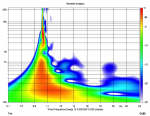Re: Frequency Response/Contour EQ in full range systems.
They can be different, or not so much. See my reply above on SMAART 7 vs. Systune.
Not only do ears not hear flat, they hear completely differently at different volume levels. No one here is suggesting that we create system curves that are the inverse of the F-M or ISO226:2003 curves, and even if we did this, what average level would we equalize to?
Mixing boards are limited devices. Limited in the amount of filtering, and limited in the degree of skill with which operators can apply those filters. To me it seems only reasonable to "build in" certain aspects to the response that are likely to be needed, regardless.
Hypothetically, lets say that all humans had extreme pain at 8kHz because of our ear physiology. In this case would it be reasonable to say "I'll tune the system flat, and the operator can just remove 8kHz with an EQ." To me, this would be a waste of an eq band, and foolish resistance against the hypothetical human anatomical bent. What I, and the other non-flat tuners in this thread, are suggesting is merely a softer form of this logic.
I think there are a few aspects to the human listening experience we can all agree upon:
The L-Acoustics posted response gets some people riled up because it looks like it has extra mid, low, and low-mid boost. Really this is because of the location of the y-axis zero line. Move the line up a little bit, so the HF instead looks "softer" and fewer people would question the curve. I personally don't try to match a curve that looks like this one, but their assertions on the overall response taper have definite merit.
Agreed.
I keep seeing a discrepancy between what the sytems measures and what the ear hears in this discussion. They are two different things.
They can be different, or not so much. See my reply above on SMAART 7 vs. Systune.
It doesn't make sense to me to claim that because the ear does not hear flat, you shouldn't tune the system flat.
Not only do ears not hear flat, they hear completely differently at different volume levels. No one here is suggesting that we create system curves that are the inverse of the F-M or ISO226:2003 curves, and even if we did this, what average level would we equalize to?
Mixing boards are limited devices. Limited in the amount of filtering, and limited in the degree of skill with which operators can apply those filters. To me it seems only reasonable to "build in" certain aspects to the response that are likely to be needed, regardless.
Hypothetically, lets say that all humans had extreme pain at 8kHz because of our ear physiology. In this case would it be reasonable to say "I'll tune the system flat, and the operator can just remove 8kHz with an EQ." To me, this would be a waste of an eq band, and foolish resistance against the hypothetical human anatomical bent. What I, and the other non-flat tuners in this thread, are suggesting is merely a softer form of this logic.
I think there are a few aspects to the human listening experience we can all agree upon:
- High frequencies are absorbed by air, we expect some amount of this. A system dead flat to 20kHz at a given point in space is preternaturally bright for most listeners. We all innately expect some VHF rolloff. Even a loudspeaker that is flat to 20kHz quickly has some built in VHF rolloff applied as sound makes it way to the listener.
- Real life objects, other than loudspeakers, have very different power response at low frequencies than high frequencies. More energy is radiated out in all direction at mid and low frequencies than at higher frequencies from every objects and instruments.
- The lack of directivity control at lower frequencies also extends to everday objects, so the low and mid energy arrivals from those objects interact more with the environment, and get more strongly included into our picture of the sound.
- At low and low-mid frequencies our brains develop to include more of this radiated energy in our hearing perception, therefore the total energy our brains "integrate" over is longer in the low and midrange that at high frequencies.
The L-Acoustics posted response gets some people riled up because it looks like it has extra mid, low, and low-mid boost. Really this is because of the location of the y-axis zero line. Move the line up a little bit, so the HF instead looks "softer" and fewer people would question the curve. I personally don't try to match a curve that looks like this one, but their assertions on the overall response taper have definite merit.
I also think it is helpful if the SE can build in flexibility to the stimulus curve so that it can be adjusted in reasonable amounts in either direction. A system that is tuned to the extremes of its capabilities lacks that flexibility.
Agreed.

